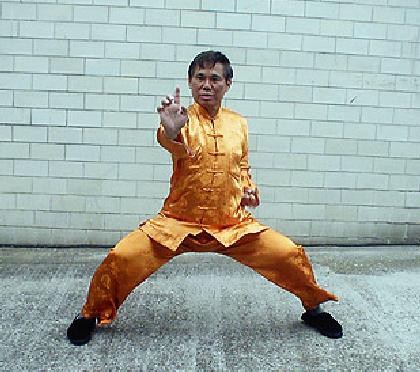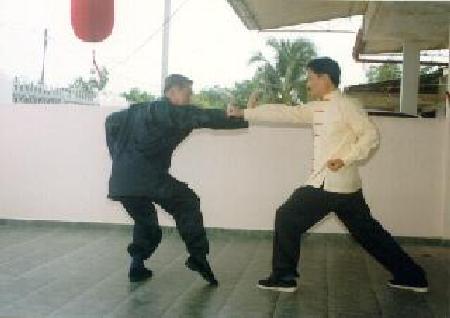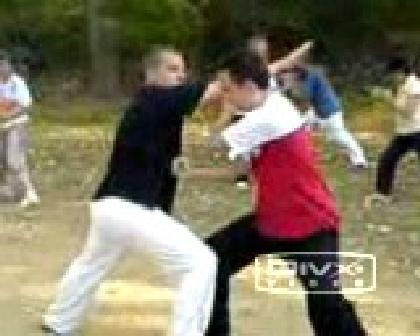October 2005 (Part 3)
SELECTION OF QUESTIONS AND ANSWERS

Sifu Wong demonstrating One-Finger Shooting Zen
Question 1
How can I be faster than any punch or kick?
— Alawadhi, UAE
Answer
The answer is through systematic and methodical training. Understandably, different schools and teachers have different methods of training.
Many people train unmethodically, mainly through free sparring, hoping that as time goes by they can become faster. They will, but the improvement is slow and haphazard.
Others train by sheer repetitions. They ask a training partner to punch and kick them, and they respond accordingly. Their improvement is faster than random free sparring, but the training is not thorough as it involves only one or two of many relevant variables, i.e. repetition of response and of movement.
In Shaolin Wahnam we train to improve as many variables as possible and we operate at the various levels of the physical, the energy and the mind.
At the physical level we train to be relaxed. If you are tensed, as many in haphazard free sparring are, both your mental and physical response will be slower. At the energetic level, we let our energy flow rather than our muscles move our physical body. This can be very fast and powerful. At the mental level we train to be calm and fresh, which enables us to see our opponent's punches and kicks clearly.
Besides training these "invisible" skills, we also train visible techniques. We practice over and over again selected techniques to counter punches and kicks, so that when an opponent punches and kicks us we response spontaneously and effectively without thinking. Yet, if we want to, we can think effectively and act accordingly, such as at which point of the opponent's body we wish to counter-strike and the amount of force we use.
It is worthy of note that all this training is holistic. In other words, we do not just train to be fast against punches and kicks. Once we have developed the skills mentioned above, we can be fast in anything we do, including in everyday non-combat situations.
While our basic training will make us fast, we also have specific methods to increase speed in our kungfu performance. Performing a kungfu set at different developmental stage is an example.
For example, at the first stage of form, students perform the kungfu set "Lohan Asks the Way" in about 5 minutes. At the second stage of form and force, students perform the set in about 3 minutes. At the third stage of form, force and speed, students perform the set in about 1 minute. Hence, students increase their speed about 5 times as they progress from stage one to stage three. All these are learnt within the few days of our Intensive Shaolin Kungfu Course.
Question 2
How do I double or triple my weight in my punch or kick?
Answer
We would prefer to use the term "force" rather than "weight" in the above question. The change of term is not just linguistic, it also represents a change of philosophy. To add weight to your punch or kick suggests adding muscles, which we avoid in Shaolin Wahnam
The principles in increasing force are similar to those described above for increasing speed.
At the physical level, we are relaxed. The more relaxed a person is, the more internal force he can generate in his punch and kick. At the energetic level, we increase both the smoothness and the volume of our energy flow. This can enable our punch and kick to he powerful and fast. At the mental level, our mind is one-pointed, enabling us to channel our internal force to our punch or kick.
Those not exposed to internal force may find the concept here alien. This is because they are used to the concept of muscular strength, and mistake it to be the only way to add weight or force to their punch and kick. Using muscular strength, besides many other disadvantages, has the innate contradiction between mass and speed. You can increase muscular strength by increasing mass or by increasing speed, but not both. When you increase mass, like having bigger muscles, you slow down speed. When you increase speed, like not tensing your muscles, you reduce force. Using internal force does not have this problem.
Question 3
How can I feel another person's chi?
Answer
Two common ways are to increase the source of chi or to sharpen your senses.
For example, when your sparring partner sweats a lot and the ventilation in your training room is poor, you can feel his negative chi in the form of toxic waste by smell.
On the other hand, when your girlfriend wearing her favorite perfume comes into your room, if you are relaxed and focused enough, you can feel her chi in the form of fragrance even with your eyes close.

Sifu Wong and Sifu Goh Kok Hin practicing a combat sequence taught at an Intensive Shaolin Kungfu Course
Question 4
Can a hair turn into a sharp weapon like a needle?
Answer
In theory, yes. In practice, very unlikely.
But why do you want to channel your energy into a hair to make it into a needle-like weapon? This will be a very poor use of your time and effort. It is more rewarding to let your energy flow harmonious in your body to make you into an example of radiant health and vitality.
Question 5
Can a Shaolin or a chi kung master slap a wall and another person behind the wall be hurt?
Answer
Yes, and this art is called "Kak San Ta Ngow" (Cantonese pronunciation), which literally means "Hitting a Buffalo Beyond a Mountain".
Question 6
Can you, Sifu Wong, hurt or heal another person with your One Finger Zen without physical touch?
Answer
Many of our Shaolin Wahnam instructors and some advanced students can hurt an opponent with a One-Finger Zen strike or other strikes but without physical contact. The energy of the strike can shoot through the space between and penetrate into the opponent's body to distort his energy network. This sounds incredible but is true.
The injury may not be serious enough to be physically visible, and the opponent would probably not notice it or feel much difference. But the fact that it is insidious makes it more harmful.
How does this distortion of energy network affect the opponent? The consequences are varied and far reaching. The following is just an example. If that affected meridian (or nerve in Western terminology) is connected to his kidneys, then his kidney functioning will be unfavorably affected. He may, for example, develop kidney stones, become fearful for no apparent reasons, or lose his sexual desire. It is unlikely that he would relate such problems to his energy network distortion caused by someone with internal force striking him without physical contact.
Actually many martial artists today have such problems without their conscious knowing. Their problems are not caused by no-contact strikes, but by uncontrolled free sparring where they freely punch and kick one another, and by their own solo training where they habitually tense their muscles which causes energy blockage.
As sparring is a prominent feature in Shaolin Wahnam training, will Shaolin Wahnam students be exposed to such risks. Definitely, no. Our instructors and senior practitioners have good control of their internal force. According to their intention, they are able not to release their force in their strikes. All Shaolin Wahanm students are able to generate their own chi flow. So, even if they accidentally sustain any injuries during sparring, their chi flow will clear away the injuries, often immediately.
But more useful than hurting, One-Finger Zen can be used for healing. I often use One-Finger Zen or Two-Finger Zen to open people's energy blockage and to transmit some energy to them for healing. For female students, especially when the vital points fall on sensitive parts of their body, I often do so without contact. Sometimes I do not even have to point my fingers at them, I use my mind.

Combat application is an essential aspect of Taijiquan training in Shaolin Wahnam. The photograph above shows Manuel deflects a palm srike from Carlos and counter-strikes with a vertical punch during a regional Taijiquan coure in Spain in August 2005
Question 7
I would like to sincerely ask you a personal question: Do you have any supernatural powers? I only ask because I think we recently had a supernatural connection and experience at far distance. You used my mouthpiece to talk to me, smiled from the heart in my chi kung practice and gave advice to better my sessions. Or is this a demon tricking me?
— Tony, USA
Answer
If you value my advice, I would strongly recommend that at present it is best for you to forget about supernatural powers. Being human and natural is wonderful enough. Life as a human is a joy everyday. Practicing your chi kung daily as it is taught to you by me, without adding anything extra, will help you to enjoy life everyday.
Question 8
I wonder if I can train only the chi kung and Shaolin from your book, "The Complete Book of Shaolin", then go to your Intensive Shaolin Kunfdu Course in the near future? If yes, which exercises should I do from the book and for how long? I mean how many years and how many minutes everyday should I do the Shaolin and chi kung exercises? For me I can do them for 3 years if you say so or more, or do the Horse Riding stance for months if you say so! For me your school is the best kung fu school in the world.
— Hugo, Sweden
Answer
I think you have made a wise choice by training from my books, then attend my Intensive Shaolin Kungfu Course. Eugene from the U.S.A. did that, and now he is quite good at Shaolin Kungfu. He was in Malaysia recently for the Advanced Combined Shaolin Taijiquan Course, which is the most advanced course I have offered so far, and he did very well in the course.
It will be better if you use my other Shaolin Kungfu book, "The Art of Shaolin Kung Fu". If you do not have this book, then "The Complete Book of Shaolin" is also a good guide. .
Here is a useful guideline. Practice the following.
- "Lifting the Sky".
- The various stances, especially the Horse-Riding Stance.
- Golden Bridge -- which will be useful as you will be doing a lot of sparring at the course.
- The four hand forms for attack and defence.
- Art of Flexible and Hundred Kicks.
- Combat Application Sequences 1 to 12.
You can get a lot of help from my website, especially the sections on Shaolin Wahnam Institute Webpages for Review and Video Galore.
An important advice is that you should be relaxed and not use muscular strength when practicing the above items. This advice may seen odd to many people. The reason for the advice is that in our school, Shaolin Kungfu is always practiced as chi kung. If you are conditioned to tense your muscles to generate strength, it may be difficult for you to unlearn that when you come for my Intensive Shaolin Kungfu Course.
The exercises are mentioned above in a progressive manner. In other words, you should learn "Lifting the Sky" first, then the various stances, and finally the combat sequences. But this does not mean that you do not practice "Lifting the Sky" at a later part of your training programme. The progression refers to learning. You can practice the exercises in any order you like.
It will be sufficient if you practice for about half an hour to an hour a day for about six months. For each session you can choose any exercises you like. At the end of each item in your practice, or at the end of each session, stand upright and be relaxed. If you feel chi is moving you, let go and enjoy your chi flow. You should enjoy your practice. Don't regard your training as work, regard it as fun.
Question 9
I would like to ask about the Taijiquan course. It says it is not meant for street fighting or prize fighting. I am wondering if the skills will be applicable to basic self defense after several years of diligent practice.
— Charles, USA
Answer
The two main items in the Intensive Taijiquan Course are internal force training and combat application. This means that a course participant will be able to defend himself (or herself) during the course itself. If he practices what he has learnt daily for a year, he should be able to handle a Black Belt in Karate, Taekwondo or Judo reasonably well.
Please have a look at https://www.shaolin.org/video-clips/courses/taijiquan-sparring.html which shows how fresh beginners learn to use Taijiquan for basic self defence in just three days. The Intensive Taijiquan Course is of a much higher level. But participants must have some prior Taijiquan experience. At least they should be able to perform some Taijiquan forms.
We mention that it is not meant for street fighting or price fighting to emphasize the gentleness of the art even when it is used for combat. Someone who wishes to learn punching and kicking aggressively and brutally as in an average street fight should not attend this course.
LINKS
Selected Reading
- The Shaolin Arts are Not merely for Cultivating Martial Arts -- Sifu Emiko Hsuen
- International Champions and Age Difference
- Index of the Question-Answer Series
- Important Questions Regarding Practice after Intensive Chi Kung Course -- Chong Baa Chuah
- Recalling the Fighting of Hoong Hei Khoon
